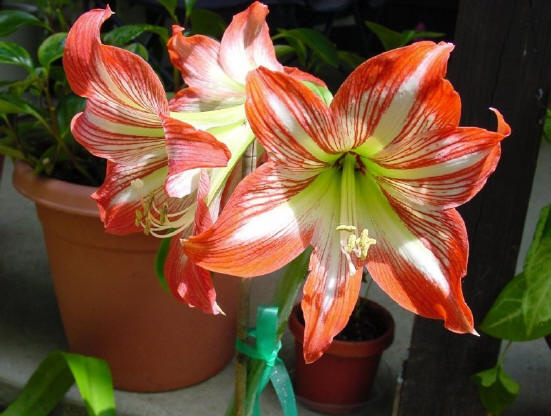The story behind the Amaryllis is one of a love struck young maiden who falls in love with the cold-hearted, handsome Alteo. In desperation, she pierces her heart with a golden arrow and visits him every day. As she walks to his cottage along the path, she sheds drops of blood. On the 13th day beautiful scarlet amaryllis flowers bloom where droplets of the blood were
shed. Alteo sees the flowers; his heart is healed and he falls in love with her. The Amaryllis was renamed in the 1800s under the genus Hippeastrium.
The Amaryllis is a tender tropical bulb most often grown in pots, growing year round outside in mild climates or outside in summers in places like Pennsylvania and Nebraska. Amaryllis can be white to pink, crimson to scarlet, stripped, stippled or mottled, mini, medium, double, large or giant.
The majorities of Amaryllis are African or Dutch and are chosen by breeders for their color, flower size and ease of growing to bloom. In their natural environment, they bloom February to April and develop their bulb strength during the summer. When fall comes, Amaryllis reach a ripe stage and at this time water is withheld from the plant. As the soil dries out. the
bulb becomes dormant until December or January when the bulbs are potted in an equal mix of perlite, rotted manure and loam. Pot size depends on the size of the Amaryllis since a 2 inch space around the bulb to the lip of the pot is recommended. Only half of the bulb should be below soil. Soil is firmly tapped in and around the bulb, and then the bulb is watered
thoroughly. Do not overwater but wait for the roots to developed, then water as needed. Blooms of Amaryllis last longer if they are kept in cooler temperatures and watered lightly.

The bulb should be fertilized with a balanced fertilizer once the flower bud has emerged. Do not apply more fertilizer than recommended by product. Flowers can last up to 6 weeks after they start growing. I’ve had blooms last 2 weeks. After the flowers have withered, clip off the stem 2 inches above the bulb. The bulb will grow a lot during the next 2 to 3 months
getting larger and producing some foliage so you must continue to water and fertilize. In Pennsylvania the bulb can be taken outside in full sunlight or continue to grow on a sunny window. The bulb will be preparing itself to bloom again next spring. In fall when leaves turn yellow withhold water and allow the soil to become dry, bring indoors to a cool, dark place about
45 degrees and place pot on its side during this dormant period.
Re-flowering: Since it can take 6 to 8 weeks from the start of growth, you can select when you initiate bulb growth. As you proceed to re-pot, check the bulb size to see if a larger pot is needed. If it has grown some offshoots, re-pot those in smaller 3 ½ pots. They will take 2 to3 years to reach flowering size.
Prorogation: Most Amaryllis are propagated by cuttings and bulbs can be cut into as many as 60 wedge shaped pieces as long as each piece contains stem tissue and base plate sections. The wedges are placed in a sand/peat mixture. Most Amaryllis are sold around Christmas time. It will take 5 years for the cuttings to reach bulb size. An Amaryllis can live up to 75 years
if properly cared for.
Our country imports about 10 million Amaryllis bulbs each year. There are over 600 varieties of Amaryllis.